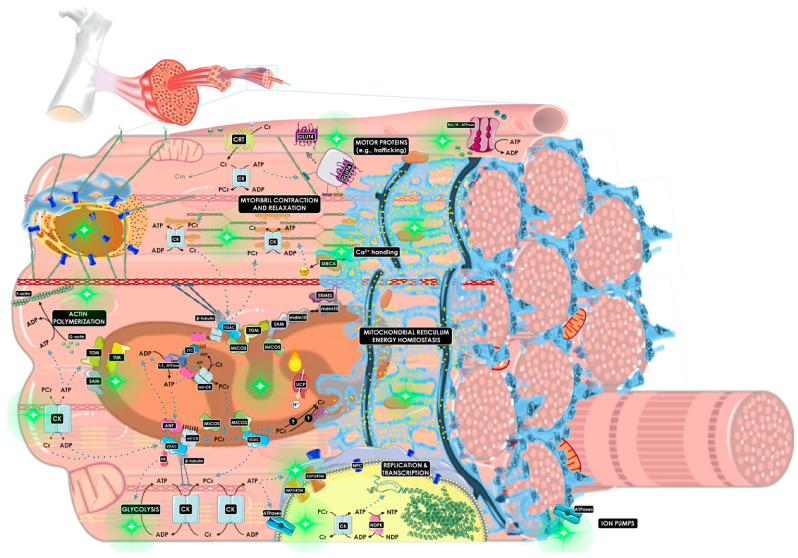Figure 3.
General overview of the CK/PCr system. The diagram represents the super-connected subcellular energy production and cellular mechanics of Cr metabolism. This chemo-mechanical energy transduction network involves structural and functional coupling of the mitochondrial reticulum (mitochondrial interactosome and oxidative metabolism), phosphagen and glycolytic system (extramitochondrial ATP production), the linker of nucleoskeleton and cytoskeleton complex (nesprins interaction with microtubules, actin polymerization, β-tubulins), motor proteins (e.g., myofibrillar ATPase machinery, vesicles transport), and ion pumps (e.g., SERCA, Na+/K+-ATPase). The cardiolipin-rich domain is represented by parallel black lines. Green sparkled circles represent the subcellular processes where the CK/PCr system is important for functionality (see the previous sections for rationale and citations). Several proteins of the endoplasmic reticulum–mitochondria organizing network (ERMIONE), the SERCA complex, the TIM/TOM complex, the MICOS complex, the linker of nucleoskeleton and cytoskeleton complex, and the architecture of sarcomere and cytoskeleton are not depicted for readability. ANT: adenine nucleotide translocase; CK: creatine kinase; Cr: creatine; Crn: creatinine; CRT: Na+/Cl−-dependent creatine transporter; ERMES: endoplasmic reticulum-mitochondria encounter structure; ETC: electron transport chain; GLUT-4: glucose transporter type 4; HK: hexokinase; mdm10: mitochondrial distribution and morphology protein 10; MICOS: mitochondrial contact site and cristae organizing system; NDPK: nucleoside-diphosphate kinase; NPC: nuclear pore complex; PCr: phosphocreatine; SAM: sorting and assembly machinery; SERCA: Sarco/Endoplasmic Reticulum Ca2+ ATPase; TIM: translocase of the inner membrane complex; TOM: translocase of the outer membrane complex; UCP: uncoupling protein; VDAC: voltage-dependent anion channel. Source: designed by the authors (D.A.B.) using figure templates developed by Servier Medical Art (Les Laboratoires Servier, Suresnes, France), licensed under a Creative Common Attribution 3.0 Generic License. http://smart.servier.com/ (accessed on 14 January 2021).

